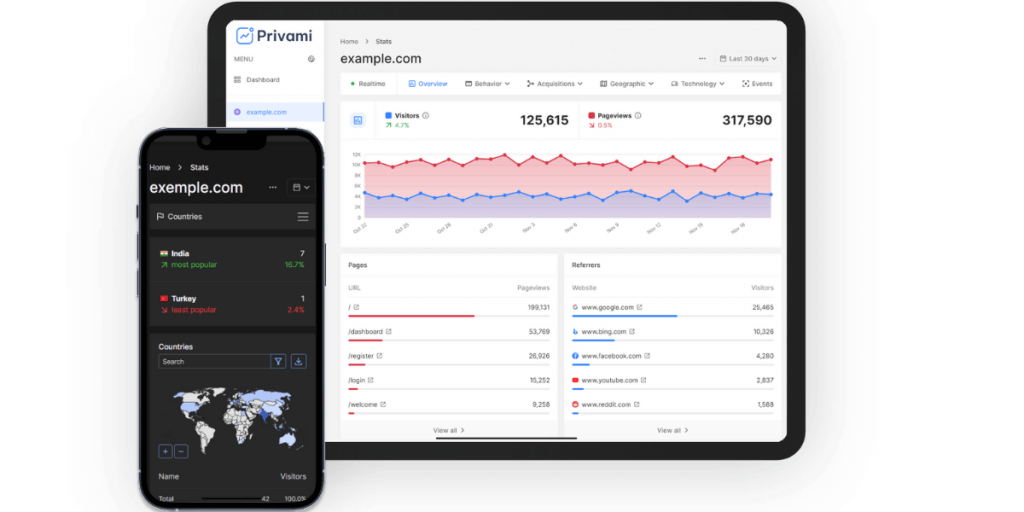
How to track visits to your website?
Understand the importance of tracking website visitors
Understanding and tracking website visitors is an integral part of the online marketing landscape, especially in 2024. This practice goes beyond mere counting of site visits; it delves into the nuanced understanding of visitor behavior. By analyzing these behaviors, businesses can identify potential leads, assess how effective their site content is, and refine strategies to boost conversion rates. A thorough analysis of traffic data uncovers trends, user preferences, and pivotal behaviors, opening avenues for targeted enhancements.
In this process, utilizing specialized tools, such as Privami, becomes indispensable. These tools offer critical insights into visitor data, which are instrumental in enhancing user experience and elevating site performance. The scope of these tracking tools ranges widely, catering to different need, from simple options suitable for personal blogs to more sophisticated systems designed for larger businesses. These tools can shed light on various aspects, like the origins of traffic, on-site user behavior, and levels of user engagement.

Key actions to follow for effective website visitor tracking
- Analyzing new vs returning visitors: This distinction is crucial for understanding visitor dynamics. By evaluating the proportion of new visitors compared to returning ones, businesses can gauge the success of their marketing strategies in attracting fresh traffic and the site’s effectiveness in maintaining visitor interest. This metric is a powerful indicator of both initial appeal and long-term engagement.
- Strategies for acquisition analysis: It’s vital to understand how customers discover and choose to visit your site. Analyzing acquisition channels helps pinpoint the most profitable avenues for investment. By scrutinizing the performance of various channels such as organic search, referrals, social media, or paid advertising, businesses can optimize their marketing efforts. This understanding allows for more strategic resource allocation, ensuring that investments are directed towards the most fruitful channels.
- Examining visitor behavior: Delving into specifics like page views, bounce rates, time spent on pages, and exit pages yields deep insights into site performance. These metrics are essential for identifying which sections of the site engage visitors effectively and which areas may require enhancements. For instance, a high bounce rate on a particular page could signal content that fails to resonate with the target audience. Understanding these patterns enables targeted improvements, enhancing the overall user experience and site effectiveness.
Strategies to increase website traffic effectively
After mastering the art of tracking your website’s traffic, the next logical step is enhancing that traffic flow. Employing certain tried-and-true methods can significantly boost your site’s traffic.
Firstly, optimizing with SEO is essential for enhancing your website’s visibility in search engine results. It involves strategic use of specific keywords, crafting compelling metadata, and optimizing landing pages. The primary goal is to improve your site’s organic ranking, increasing the likelihood of attracting users searching for relevant terms in your niche.
Another possibility is to use SEM to place paid advertisements on platforms such as Google. This approach complements SEO by targeting specific keywords that are challenging to rank organically. SEM allows for rapid audience targeting, although it requires budgeting. Its success depends on creating ads that are relevant and align with what your audience is searching for, thereby maximizing click-through rates and conversions.
Additionally, engaging in blog writing significantly increases visitor traffic. By providing high-quality, relevant content, you deliver valuable information to your audience, reinforcing your SEO efforts. Each blog post opens up new opportunities for search engine ranking. Blogging also serves as an effective medium for content sharing on social media, promoting increased engagement and driving referral traffic.
By implementing these strategies, you’re not just increasing the volume of your web traffic; you’re also enhancing the quality of the visitors to your site. This is key to boosting conversion rates and solidifying your business’s online footprint.
Understanding key SEO metrics and their impact on website visit tracking
SEO metrics are pivotal in evaluating the effectiveness of digital marketing efforts. These data sets allow marketers to quantify the impact of SEO on their campaigns and fine-tune strategies for optimal results.

Essential SEO metrics to monitor
- Monitoring engagement rate: This metric is a cornerstone in assessing how users interact with your site. It encompasses clicks, scrolls, and conversions, painting a comprehensive picture of visitor engagement. A robust engagement rate typically signifies content that is both engaging and relevant, prompting users to interact more with your site. Crafting content that deeply resonates with your target audience is key to sustaining and enhancing this engagement.
- Analyzing form interactions: It’s equally important to understand how visitors interact with forms on your website. Metrics to consider include form completion rates, user behavior during form completion, and points where users abandon the form. Analyzing these aspects can unveil critical insights into the user experience, highlighting obstacles that might impede conversions.
- Evaluating landing page Effectiveness: Reports on landing page performance provide invaluable insights into visitor interactions with the first page they encounter on your site. Such reports can identify which landing pages effectively captivate visitors’ interest and encourage further exploration of your site. Optimizing landing pages for both SEO and user experience is vital for augmenting conversion rates.
- Tracking organic search traffic: This metric is crucial for understanding how effective your SEO strategies are in attracting visitors from search engines. Monitoring the volume of organic traffic gives a clear indication of your website’s visibility in search engine results pages (SERPs). An increase in organic traffic often correlates with improved keyword rankings and successful SEO practices. Regular analysis of this data can guide your ongoing SEO efforts and content strategy.
- Tracking conversion rates: Ultimately, the goal of most websites is to convert visitors into customers or leads. Monitoring conversion rates from various traffic sources, including organic search, can provide valuable insights into how well your SEO efforts are translating into tangible results. This involves analyzing the effectiveness of calls to action, the user journey through the site, and the overall user experience.
- Analyzing content performance: Understanding which pieces of content are most effective in attracting and engaging visitors is crucial. This can be measured through metrics such as page views, time spent on page, social shares, and comments. Content performance analysis helps in identifying topics that resonate with your audience and in planning future content strategies.
- Measuring keyword rankings: Regularly tracking the rankings for key search terms related to your business or content can provide insights into your website’s performance in SERPs. This metric helps in understanding how well your site is competing for targeted keywords and identifies areas for improvement. Staying aware of both high-performing and underperforming keywords can guide content optimization and link-building strategies. Assessing Bounce Rate and Time on Page: Bounce rate measures the percentage of visitors who leave your site after viewing only one page, while time on page reflects how long visitors stay on a page. Both metrics offer insights into user engagement and content relevance. A high bounce rate and low time on page might indicate that your content is not meeting user expectations or that your site is not user-friendly.
- Analyzing backlink profile: The quality and quantity of backlinks to your website are significant for SEO. Tracking your backlink profile helps in understanding the impact of your link-building strategies and the authority of your website in the eyes of search engines. Regularly monitoring for new backlinks, and assessing the quality of referring domains, is essential for maintaining a healthy backlink profile. Monitoring Page Load Speed: Page load speed is a critical SEO factor, as slow can negatively impact user experience and, consequently, search engine rankings. Regularly measuring and improving the load times of your web pages is essential. This involves monitoring metrics like First Contentful Paint (FCP) and Time to Interactive (TTI). Faster load times can reduce bounce rates and improve overall user satisfaction, which in turn can lead to higher engagement and conversion rates.
- Web site health checks: Regular audits of your website for technical SEO issues are essential. This includes checking for broken links, crawl errors, duplicate content, and ensuring proper indexing by search engines. Maintaining a technically sound website is foundational for effective SEO. We advise you to use Auxseo, a platform offering detailed, easy-to-understand reports for website evaluation, as well as access to a database of essential tools for improving your website.
- Checking mobile usability: With the increasing use of smartphones for internet browsing, it’s crucial to ensure your website is mobile-friendly. Metrics to monitor include mobile traffic percentages, user engagement on mobile devices, and mobile conversion rates. Google’s mobile-first indexing makes this even more important, as it bases rankings on the mobile version of your site.
Exploring the broader dimensions of seo beyond standard metrics
SEO extends far beyond the conventional metrics of traffic and clicks. To fully grasp its influence on sales, it’s essential to consider additional, often overlooked aspects.
First of all, you can develop email lists with SEO-optimized content. Regular publication of SEO-rich content on a blog is a strategic method for expanding an email subscriber base. By offering valuable content, websites attract visitors who are likely to sign up for updates, thereby creating a pool of qualified leads. These leads can then be effectively targeted in future marketing campaigns, enhancing the potential for conversions.
In addition, it’s important to create synergy between SEO and PPC (Pay Per Click) to generate traffic. The traffic generated from SEO efforts can be synergistically used to boost PPC campaign performance. Incorporating long-tail keywords within SEO content can draw visitors with specific search intents. This specificity enhances the effectiveness of PPC campaigns that target these identical keywords, leading to a more targeted approach and potentially higher conversion rates.
With evolving search engine trends, such as continuous scrolling on SERPs (Search engine results pages), the role of high-quality, engaging images has become increasingly significant. Images that are both relevant and captivating can enhance click-through rates and bolster user engagement. This, in turn, contributes positively to SEO rankings, as visually appealing content often encourages longer site visits and deeper interaction.
Exploring the relationship between content engagement and customer lifetime value
Exploring the relationship between content engagement and customer lifetime value involves focusing on how users interact with and value your site’s content. Key indicators of content engagement include metrics like scroll depth, clicks, and video playbacks. High levels of engagement in these areas indicate that the content resonates well with the audience. Creating content that is appealing, informative, and engaging is crucial for retaining visitors and encouraging them to engage with your offerings.
Please note that understanding customer lifetime value (CLV) is also essential, especially for businesses with subscription models. CLV represents the total revenue a customer is expected to generate throughout their engagement with your brand. Monitoring CLV helps in understanding the long-term impact of SEO on revenue streams. SEO initiatives attracting high-value customers can significantly increase CLV, highlighting the importance of not just increasing traffic, but also attracting higher quality traffic. This approach underlines the need for targeted SEO strategies that focus on both the quantity and quality of customer acquisition and retention.
Optimization and analytics for enhanced understanding of website visits
Understanding and optimizing website visits requires a comprehensive approach, focusing not only on traffic but also on brand visibility, conversions, revenue, and the impact of SEO:
- Evaluating brand visibility: Monitoring brand mentions and brand-related search clicks is vital for understanding their influence on conversions. Clicks originating from Google searches that are not directly related to the brand signify the effectiveness of your SEO in drawing in traffic. This metric is instrumental in evaluating how well your content and keyword strategies are performing in attracting a broader audience.
- Assessing conversions and conversion rates: The interplay between conversions and conversion rates is crucial in measuring your site’s proficiency in transforming visitors into concrete actions. Whether it’s through sales, form submissions, or downloads, these actions reflect the success of your SEO and marketing strategies in engaging visitors and prompting them to act.
- Measuring Revenue Generated by SEO: It’s essential to track the revenue attributable to SEO efforts to understand its return on investment. Beyond just organic metrics, overall revenue should also be considered, as SEO can have a ripple effect on other marketing channels, contributing to overall qualified traffic.
- Monitoring Clicks and Impressions: The count of clicks and impressions a website receives is a fundamental indicator of its visibility and attractiveness in search engines. Impressions can lead to clicks, and clicks can culminate in conversions. Therefore, optimizing your content and metadata to improve these metrics is a key component of a successful SEO strategy.
Leveraging privami for advanced web traffic analysis
Leveraging Privami for advanced web traffic analysis integrates an advanced solution into your website tracking, crucial for businesses aiming to enhance their online presence. Privami delivers comprehensive insights into visitor behavior, including monitoring user journeys, pinpointing high-performing pages, and scrutinizing potential friction points. This level of detail helps in tracking the origin of visitors and understanding their interactions with the website.
Privami’s synergy with SEO efforts is a significant benefit, offering an in-depth look at user interactions to aid in pinpointing areas for content and website optimization, thus bolstering search engine rankings. This enhanced analysis can lead to a surge in qualified organic traffic and overall better site performance.
Privami enables a deep dive beyond basic metrics, providing an intricate understanding of visitor behavior, key in identifying ways to boost user engagement and conversion rates. Understanding visitor navigation patterns, content preferences, and dropout points allows for targeted modifications to refine the user experience.

Additionally, Privami is instrumental in measuring and optimizing conversion rates. By evaluating web traffic data, it identifies the most efficacious strategies to transform visitors into customers. This data-centric approach facilitates informed decision-making and ongoing refinement of marketing strategies and website content.
Incorporating Privami into your web traffic analysis strategy aids in improving SEO rankings and user engagement, enhancing the overall value derived from each visitor. This integration transforms digital marketing efforts into quantifiable and impactful results.
To conclude, mastering the intricacies of website visit tracking is pivotal for achieving success in the digital marketing realm. By diligently optimizing SEO strategies, vigilantly monitoring critical metrics, and meticulously analyzing visitor behaviors, marketers can gain invaluable insights. These insights are key in converting marketing initiatives into concrete, measurable outcomes. They also play a crucial role in enhancing user engagement and boosting overall profitability. The incorporation of sophisticated tools like Privami into this process significantly elevates the depth of analysis, enabling a more nuanced understanding and precise optimization of web traffic. Such comprehensive and informed approaches are indispensable for businesses aiming to excel in today’s highly competitive digital landscape.

